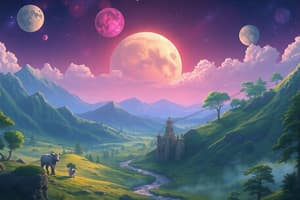Podcast
Questions and Answers
What is the primary function of an ecosystem?
What is the primary function of an ecosystem?
To allow the flow of energy and nutrients.
What are the two major components of an ecosystem?
What are the two major components of an ecosystem?
- terrestrial and aquatic
- biotic and abiotic (correct)
- living and non-living
- organic and inorganic
Which of the following is NOT a physical component of an ecosystem?
Which of the following is NOT a physical component of an ecosystem?
- population (correct)
- climate
- raw materials
- energy
The sources of nutrients in an ecosystem are ______ components.
The sources of nutrients in an ecosystem are ______ components.
Give an example of an organic substance found in an ecosystem.
Give an example of an organic substance found in an ecosystem.
What are the living members of a community called?
What are the living members of a community called?
Autotrophs are also known as heterotrophs.
Autotrophs are also known as heterotrophs.
Which of the following is an example of an autotroph?
Which of the following is an example of an autotroph?
Heterotrophs are also called consumers.
Heterotrophs are also called consumers.
What type of consumer is a deer?
What type of consumer is a deer?
What are the main roles of decomposers in an ecosystem?
What are the main roles of decomposers in an ecosystem?
Energy flow in an ecosystem is unidirectional.
Energy flow in an ecosystem is unidirectional.
What is ecological succession?
What is ecological succession?
Which of the following is the first stage of ecological succession?
Which of the following is the first stage of ecological succession?
Secondary succession occurs in areas where no previous life existed before.
Secondary succession occurs in areas where no previous life existed before.
Match the following types of ecological succession with their starting environments:
Match the following types of ecological succession with their starting environments:
What is the primary difference between a food chain and a food web?
What is the primary difference between a food chain and a food web?
Food webs are more stable than food chains.
Food webs are more stable than food chains.
Name two functions of food webs.
Name two functions of food webs.
Biomagnification refers to the decrease in the concentration of a substance as it moves up the food chain.
Biomagnification refers to the decrease in the concentration of a substance as it moves up the food chain.
What type of substance is often involved in biomagnification?
What type of substance is often involved in biomagnification?
Which of the following is NOT a characteristic of a desert ecosystem?
Which of the following is NOT a characteristic of a desert ecosystem?
What is the primary function of an ecological pyramid?
What is the primary function of an ecological pyramid?
Which type of ecological pyramid shows the amount of energy present at each trophic level?
Which type of ecological pyramid shows the amount of energy present at each trophic level?
The base of a pyramid of biomass always represents the producers.
The base of a pyramid of biomass always represents the producers.
What is a keystone species?
What is a keystone species?
How do elephants act as keystone species in grasslands?
How do elephants act as keystone species in grasslands?
What is biodiversity?
What is biodiversity?
Which of the following is NOT a level of biodiversity?
Which of the following is NOT a level of biodiversity?
What are endemic species?
What are endemic species?
Which of the following is a major threat to biodiversity?
Which of the following is a major threat to biodiversity?
In-situ conservation involves protecting species in their natural habitat.
In-situ conservation involves protecting species in their natural habitat.
Which of the following is a disadvantage of in-situ conservation?
Which of the following is a disadvantage of in-situ conservation?
Ex-situ conservation involves protecting species outside their natural habitat, for example, in zoos or botanical gardens.
Ex-situ conservation involves protecting species outside their natural habitat, for example, in zoos or botanical gardens.
Which of the following is NOT a benefit of ex-situ conservation?
Which of the following is NOT a benefit of ex-situ conservation?
What are some examples of man-wildlife conflict?
What are some examples of man-wildlife conflict?
Genetic pollution can be a serious threat to endemic species.
Genetic pollution can be a serious threat to endemic species.
Biodiversity hotspots are areas with high concentrations of endemic species.
Biodiversity hotspots are areas with high concentrations of endemic species.
What is the main goal of conservation efforts?
What is the main goal of conservation efforts?
Flashcards
Ecology
Ecology
The study of how organisms interact with each other and their environment.
Ecosystem
Ecosystem
A community of organisms interacting with their physical environment.
Abiotic components
Abiotic components
Non-living parts of an ecosystem, like sunlight and water.
Biotic components
Biotic components
Signup and view all the flashcards
Producers
Producers
Signup and view all the flashcards
Consumers
Consumers
Signup and view all the flashcards
Decomposers
Decomposers
Signup and view all the flashcards
Food chain
Food chain
Signup and view all the flashcards
Food web
Food web
Signup and view all the flashcards
Trophic levels
Trophic levels
Signup and view all the flashcards
Ecological pyramid
Ecological pyramid
Signup and view all the flashcards
Primary succession
Primary succession
Signup and view all the flashcards
Secondary succession
Secondary succession
Signup and view all the flashcards
Biomagnification
Biomagnification
Signup and view all the flashcards
Biodiversity
Biodiversity
Signup and view all the flashcards
Genetic diversity
Genetic diversity
Signup and view all the flashcards
Species diversity
Species diversity
Signup and view all the flashcards
Ecosystem diversity
Ecosystem diversity
Signup and view all the flashcards
Keystone species
Keystone species
Signup and view all the flashcards
Habitat loss
Habitat loss
Signup and view all the flashcards
Poaching
Poaching
Signup and view all the flashcards
Man-wildlife conflict
Man-wildlife conflict
Signup and view all the flashcards
Invasive species
Invasive species
Signup and view all the flashcards
Ex-situ conservation
Ex-situ conservation
Signup and view all the flashcards
In-situ conservation
In-situ conservation
Signup and view all the flashcards
Study Notes
Ecology and Ecosystems
- Ecology is the study of the relationship between organisms and their environment (living and non-living).
- An ecosystem is the basic functional unit of ecology. It involves interacting organisms and their environment, exchanging energy and matter (e.g., forests, deserts).
- A biome is a smaller ecosystem within a larger ecosystem, characterized by dominant species with similar lifestyles, climates, and physical structures.
Types of Ecosystems
- Ecosystems are classified as natural or artificial/man-engineered.
- Natural ecosystems include terrestrial (e.g., croplands, dams) and aquatic (e.g., marine, freshwater).
- Freshwater ecosystems can be lotic (running water, e.g., springs, streams, rivers) or lentic (standing water, e.g., lakes, ponds, pools).
Structure of an Ecosystem
- Ecosystems have two major components: abiotic and biotic.
- Abiotic components are non-living parts, including energy, climate, raw materials, and living space (e.g., air, water, soil, sunlight, nutrients).
- Biotic components are living parts, categorized as autotrophs/producers (prepare their own food, e.g., plants) and heterotrophs/consumers (cannot prepare food, relying on producers, e.g., herbivores, carnivores) and decomposers (break down dead organisms, e.g., bacteria, fungi).
Classification of Biotic Components
- Autotrophs/producers prepare food through photosynthesis (using chlorophyll, CO2 and sunlight).
- Heterotrophs/consumers depend on producers for food.
- Primary consumers (herbivores) feed on plants.
- Secondary consumers (primary carnivores) feed on primary consumers.
- Tertiary consumers (secondary carnivores) feed on secondary consumers.
- Decomposers feed on dead organisms and return nutrients to the environment.
Function of an Ecosystem
- The main function of an ecosystem is to allow the flow of energy and nutrients between organisms. This happens via:
- Primary function – producing matter through photosynthesis
- Secondary function – distributing the matter in the form of food for consumers
- Tertiary function – processes the dead organic matter to reintroduce the substances back into the environment through cycling by decomposers (decomposition)
Energy Flow in an Ecosystem
- Solar energy is the primary energy source on earth.
- Plants convert solar energy into chemical energy through photosynthesis.
- Energy flows through the ecosystem in a unidirectional manner from producers to consumers.
- 10% of energy is transferred to the next trophic level while 90% of energy is lost as heat.
- Energy flow is governed by the laws of thermodynamics, the first law stating energy can neither be created nor destroyed but can be converted from one form to another and the second law stating when energy or matter converts from one form to another, some energy is always lost as heat.
Ecological Succession
- Ecological succession involves the progressive replacement of one community by another until a stable community develops.
- This occurs in two ways, primary succession (development of biotic community on lifeless ground, like a newly formed volcanic land or a rock), or secondary succession (development of biotic communities in an already existing biotic community, like a forest fire).
Food Webs
- A food web is the interconnected feeding pattern of various food chains in an ecosystem.
- Interactions amongst various trophic levels (producer, primary consumer, secondary consumer, etc.; from the lowest and to the highest on the food chain) are interconnected.
- Food webs are essential for maintaining the stability of ecosystems.
Ecological Pyramids
- Ecological pyramids are graphical representations of the structure and function of trophic levels of an ecosystem.
- Pyramids of energy – represent the amount of energy present in each trophic level.
- Pyramids of biomass – represent the total mass of organisms at each trophic level.
- Significant loss of energy occurs at each trophic level (10%) which is lost as heat.
Forest Ecosystems
- Forests consist of densely growing trees, covering a significant portion of the Earth's land.
- Various types of forests exist, categorized by climate and vegetation (e.g. tropical rain forest, tropical deciduous forest, temperate rain forest, temperate deciduous forest).
- Forest ecosystems have specific abiotic and biotic components. These include producers (trees, shrubs), consumers (herbivores, carnivores), and decomposers (bacteria, fungi).
Grassland Ecosystems
- Grasslands are large areas dominated by grasses, with scattered trees.
- Different types of grasslands exist, categorized by temperature and rainfall (e.g., tropical grasslands, temperate grasslands, polar grasslands).
- Grasslands support different types of producers, consumers, and decomposers.
Desert Ecosystems
- Deserts are characterized by low precipitation, high temperatures, and sparse vegetation.
- Deserts support specific types of producers (shrubs, bushes, and some grasses) and consumers (reptiles, mammals).
- Decomposers (fungi and bacteria) are also present though less compared to other types of ecosystems.
Aquatic Ecosystems
- Aquatic ecosystems consist of freshwater (e.g., ponds, lakes, rivers, streams) and marine (e.g., oceans, estuaries).
- In fresh water ecosystems, the biotic components are producers (phytoplankton, algae, water grasses), consumers (insects, snails, birds, mammals), and decomposers (fungi, bacteria).
- In marine ecosystems like oceans, the biotic components are also the same as in freshwater ecosystems but may have different species.
- Aquatic ecosystems play a crucial role in global processes such as nutrient cycling and water regulation.
Estuarine Ecosystems
- Estuaries are transitional zones where freshwater rivers meet the ocean.
- Characterized by fluctuating salinity, periodic tidal changes, and high biodiversity and nutrient levels.
- Estuarine ecosystems are crucial for providing habitat and food for many species transitioning between freshwater and saltwater environments.
- Abiotic components include temperature, pH, sodium salts, potassium salts, and other elements.
Biodiversity
- Biodiversity means the variety of life on Earth.
- Levels of biodiversity include genetic, species, and ecosystem diversity.
- Key biodiversity components include producers, consumers, and decomposers.
- Various factors influence biodiversity in ecosystems, including climate, vegetation, and resources.
Conservation of Biodiversity
- Conservation of biodiversity is essential to maintain healthy ecosystems.
- Various conservation strategies exist, including in-situ (preserving species in their natural habitats) and ex-situ (preserving species outside their natural habitats).
- Both in-situ and ex-situ conservation strategies aim to maintain and preserve biodiversity to avoid extinction and assure their continued role in ecosystems.
Studying That Suits You
Use AI to generate personalized quizzes and flashcards to suit your learning preferences.




